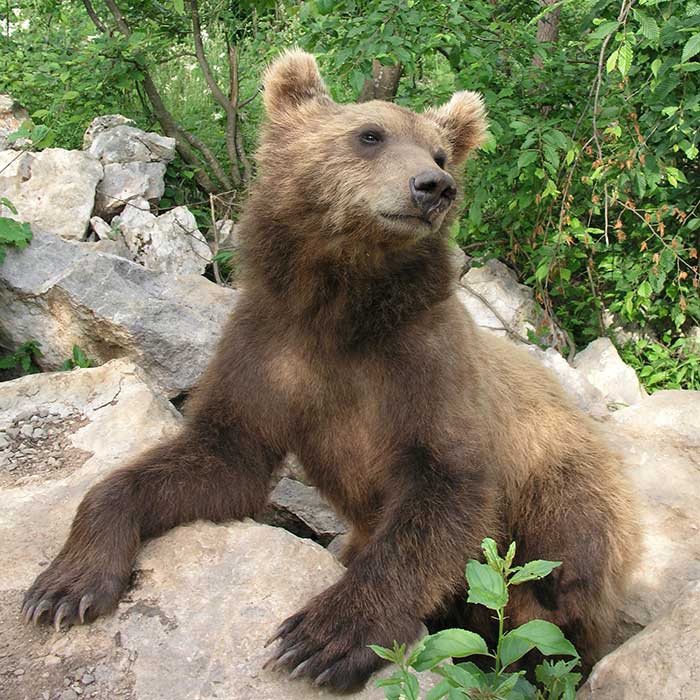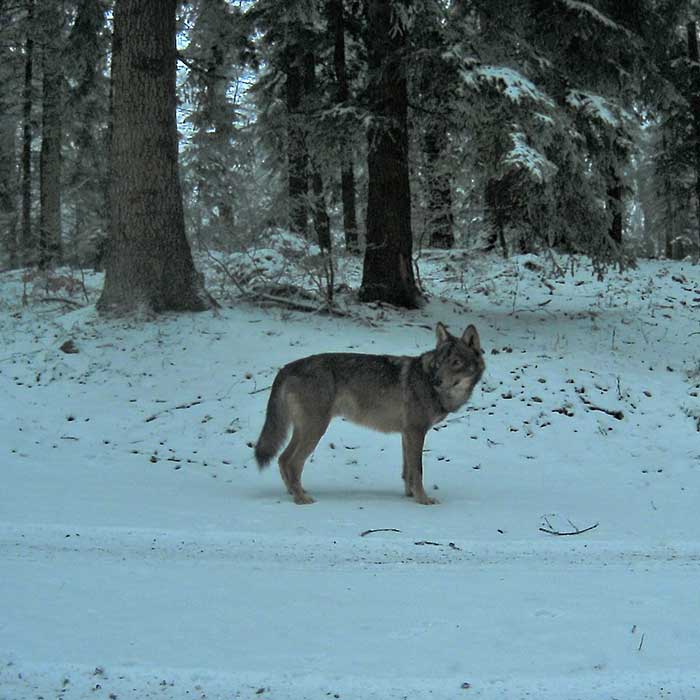Fauna
The fauna of Velebit is diverse and very valuable. “We can find here large carnivores (wolf, bear, lynx, wild cat) and other mammals (boar, roe, deer, chamois), birds such as capercaillie, hazel grouse, golden eagle, different owl and woodpecker species and numerous typical mountain species. There are also some species of smaller carnivores, such as mustelid, badger and fox and especially important are the glacial relict of the Dinarides the Balkan snow vole (Dinaromys bogdanovi) and garden dormouse (Eliomys quercinus dalmaticus). There are many reptile species on Velebit (especially on the coastal side where one can find our protected vipers, the nose-horned viper and the common adder. In the area of Velebit there are also numerous species of diurnal butterflies, mostly from the Nymphalidae family. Since many of them are endangered, they are included in the Croatian and European Red List of Butterflies.
Especially valuable are branched cave systems, which abound in steno-endemic fauna.”
Large carnivores in the Velebit Nature Park:

Brown bearUrsus arctos
The brown bear is our largest carnivore.
The weight of adult males can exceed 300 kg while females weigh up to 150 kg. Their shoulder height ranges between 100 and 120 cm but when they stand on their hind legs their height can even reach 2.3 m. Although bears are carnivores, they satisfy almost 95 percent of their dietary needs with plant food and the remaining 5 percent with animal food consisting predominantly of insects and their larvae or carcasses. They can even steal prey from other predators, most frequently from the lynx. They spend winter in their lair in partial hibernation meaning that they can wake up rather easily and at the same time, in January, females deliver cubs weighing only 300 grams. Because mother’s milk is exceptionally nutritious, cubs grow quickly and when the snow melts in April they can already follow their mothers in search of food. Bears are not territorial animals meaning that they share the territory but they still avoid mutual contacts. Especially females with cubs avoid contact with males. They mark their presence at a certain territory by scraping and biting the bark of coniferous trees and scratching their back on trees leaving thus their scent.
The bear can be found all over Velebit, even in the coastal area.
The bear is a species protected under the Nature Protection Act and Hunting Act but with the right of hunting in line with the Brown Bear Management Plan for the Republic of Croatia.

Grey wolf Canis lupus
The wolf is a member of the order Carnivora and family Canidae.
The weight of adult males can exceed 40 kg but it is on average 35 kg. Their shoulder height averages 70 cm and their length from muzzle to tail end is about 170 cm. Their colour varies from one individual to another and depends on the season but is in general grey and brown with darker parts. There are two distinctive darker stripes on their front legs.
The wolf is an extremely territorial species living in packs ruled by strict hierarchical relationships which limit breeding to only one reproductive, so-called alpha pair. All other pack members are their offspring and take joint care of the new litter.
The size of a pack territory depends on the number of members of the pack, the amount of prey as well as on the size and strength of neighbouring packs. The research of wolf territory undertaken so far in Croatia showed that the territory size ranges from 150 to 700 km2. Wolves can be found in the whole area of the Dinarides and are strictly protected under the Nature Protection Act.

Eurasian lynx Lynx lynx
The lynx is a member of the order Carnivora and family Felidae.
The average weight of males is 21 kg while females are somewhat lighter. Their length ranges between 80 and 130 cm and their shoulder height averages 60 cm. They have a short tail, measuring 15 to 20 cm, with a black tip. Their fur is reddish and brown with more or less distinct black spots which vary in number and pattern for each individual providing thus a distinguishing feature. Other specific features include black tufts of hair on their ears and retracted claws found in most cats.
The lynx is a territorial, solitary animal so each individual has its territory. Territory size depends on the prey, population density and differs between males and females. They mark their living area by different scents from glands, urine and faeces.
At the beginning of the 20th century the lynx was completely extirpated in Croatia and was repopulated in Slovenia in 1973 wherefrom it gradually spread to inhabit today the entire area of Velebit up to the coast.
The lynx is a species strictly protected under the Nature Protection Act.





